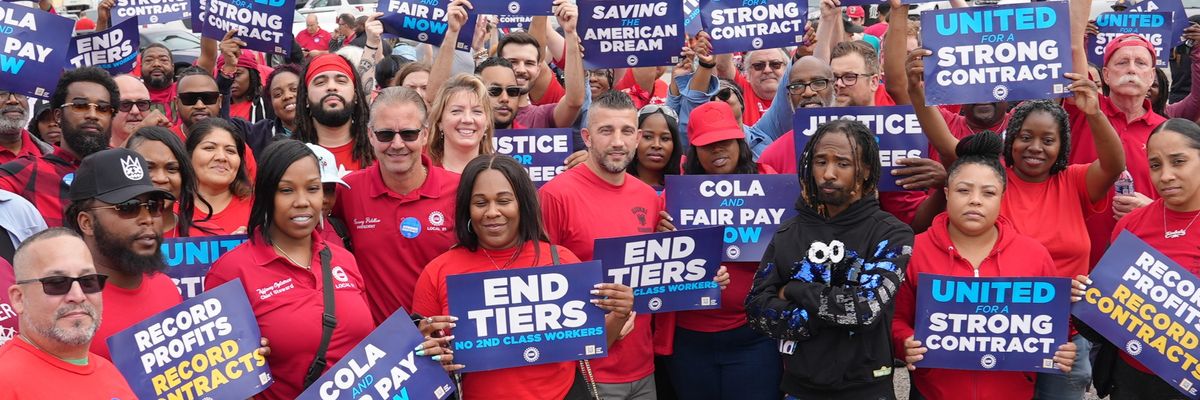The United Auto Workers has scored major victories in its new contracts with the Big Three automakers: GM, Ford, and Stellantis. Not only did the union win massive wage increases and other critical demands, but it also won the virtually unheard of right to strike over plant closures. This historic victory could have significant benefits for all working people.
Since the dawn of capitalism, plant closings and mass layoffs have disrupted working-class lives. The problem rapidly accelerated when Republican and Democratic administrations, starting with Reagan in 1980, freed Wall Street from regulations that discouraged job-killing leveraged corporate takeovers and stock buybacks. While researching my upcoming book, Wall Street’s War on Workers, we found that more than 30 million workers have been subjected to mass layoffs since 1996.
The auto industry was one of the first to institute mass layoffs as mismanagement and stiff competition from abroad in the 1970s cut into the Big Three’s market share. Until this recent UAW contract, unions mostly had been unable to stop mass layoffs. Instead, they only had the contractual right to conduct “effects bargaining,” negotiating to secure severance payments for the workers who would be let go. Even if they had wanted to strike, in most cases it would have been prohibited by their contracts.
The UAW has changed that game. If GM or Ford or Stellantis decide to shut down a facility going forward, they will now be forced to think twice. Is the risk of a national strike that could cost them billions, worth the short-term savings that come with layoffs? Or might it make more sense to find another use for the facility and keep everyone working? The new UAW contracts with the Big Three bring this entirely new financial dynamic into the mass layoff game. Already, Stellantis has agreed to reopen its plant in Belvidere, Illinois, and rehire all 1,200 laid-off workers there.
As Stellantis just demonstrated by reopening its Belvidere facility, large corporations are far more flexible than their public rhetoric suggests.
But doesn’t forcing the companies to keep those workers employed weaken them and make them less competitive? That’s what corporations always claim… at least until persuaded and pressured to do otherwise. However, corporate leaders know that mass layoffs often have little to do with production and sales. In many cases, mass layoffs are used to squeeze more cash out of the company to finance stock buybacks – a legalized form of stock manipulation that enriches top corporate officials and Wall Street stock-sellers (see Mass Layoff Capitalism). For example, in the last 12 years, GM has poured more than $21 billion into stock buybacks. No one knows for certain how many jobs were lost to help finance those buybacks, but the number is certainly significant. In 2015 alone, the company laid off 14,000 employees.
Our research suggests that in many, if not most, cases, stock buybacks and/or leveraged buyouts precede mass layoffs. Companies like Toys “R” Us and Bed, Bath and Beyond have been ruined by that process.
But what if an auto company really can’t sell one of its products? How then could it possibly keep a plant open?
As Stellantis just demonstrated by reopening its Belvidere facility, large corporations are far more flexible than their public rhetoric suggests. They are adept at finding ways to cut costs by outsourcing work to non-union labor, here and abroad. If pressured, they have the capacity to redirect that production to facilities that are being shut down here and re-employ union labor.
An excellent example of this flexibility can be found at Siemens Energy. The company decided in 2020 to quit the oil drilling and fracking businesses and announced layoffs of approximately 1,700 U.S. workers and another 3,000 thousand in Germany. In the U.S., all the layoffs took place and the unions involved conducted effects bargaining. But in Germany, where workers hold half the seats on the Siemens board of directors, the union won an agreement that there would be no compulsory layoffs. Instead, the company was allowed to try to entice workers to leave voluntarily with significant pay and benefit packages. The company also agreed to put new production into the six facilities that were originally scheduled to be shut down.
The UAW is forging a new path to build real union power to stop corporate mass layoffs through the right to strike.
In the U.S., workers do not have that kind of leverage on boards of directors. In Germany, it is mandated by laws urged upon them by the U.S. after WWII. The UAW is forging a new path to build real union power to stop corporate mass layoffs through the right to strike.
Shawn Fain, the visionary and effective UAW president, wants these union successes to spread far and wide. He is urging every union to have their contracts end on the same date—May 1, 2028—the internationally recognized Labor Day, which honors the 1892 Homestead strike for the eight-hour work day. With concerted pressure, perhaps the labor movement would develop broader, basic common demands that support the working class. Stopping needless mass layoffs should be near the top of the list.
Can you imagine if every union had the right to strike over mass layoffs and then succeeded in protecting job security? That might lead to an explosion of workers wanting to join unions. We might even see a repeat of a legendary story from the diary of a union organizer during the 1940s: “Today I organized 12 new local unions,” he wrote. Of course, he didn’t go out and organize each one on his own. They were running into the organizer’s office requesting union charters.
Today, for the first time in a long, long time, there’s a decent chance that workers will be running to the UAW.
